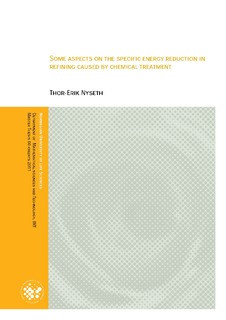| dc.description.abstract | Mechanical pulping is a process for production of wood pulp in papermaking. Thermomechanical Pulp (TMP) and Groundwood (GW) are historically the two production methods used for mechanical pulping. Because of high electrical prices and increasing requirements in pulp quality it is of interest to improve the mechanical pulping process. The Advanced Thermomechanical Pulp (ATMP) process is a development of the TMP process developed to reduce the electrical energy consumption in production of mechanical pulp. ATMP also has better strength properties and optical properties compared to TMP. Andritz, Paper and Fibre Research Institute (PFI) and Norske Skog together have developed this production method throughout several pilot plant trials with excellent results.
Mechanical pre-treatment of wood chips with a screw press and chemical addition in a high intensity primary refining stage are the features of the ATMP process. This process has recently been described (Hill et al. 2009, Hill et al. 2010, Gorski et al. 2011 and Johansson et al. 2011). Improvements in the electrical energy efficiency in refining of up to 0,65 MWh/odt or 34 % as well as higher brightness and lower shive contents compared to reference TMP pulp were shown for spruce raw material (Gorski et al. 2011).
To further understand what happens with the pulp in ATMP process compared to the TMP process different investigations were carried out. Methylene blue sorption were evaluated and used to measure the total amount of anionic groups on both ATMP and TMP produced pulps. ATMP produced pulps achieved a higher number of acidic groups compared to pulps without addition of chemicals for not only the whole pulp but also for three different fractions of each pulp. Additional tests are now carried out with conductometric titration to further verify the results from these tests. Laboratory sheets were produced from different fibre fractions of these pulps. Optical properties, strength properties, Ambertec formation and charge decay properties were measured on these sheets. The brightness and light absorption were significantly better for all fractions of ATMP pulps compared to pulps without addition of chemicals. Pulps added bisulphite achieved the highest light absorption and lowest light scattering in these trials. The results from light scattering showed that pulps produced without addition of chemicals achieved significantly poorer result for the long fraction compared to the other pulps. However, for the middle and fines fraction the ATMP produced pulps achieved high light scattering but not necessary the highest light scattering. TMP achieved high light scattering for both the middle and fines fraction. It is however difficult to compare the different ATMP pulps without an optimization of the addition of chemicals. Both strain and tensile index were measured to calculate the Tensile Energy Absorption (TEA). These results showed that to produce pulp with high intensity in the primary refining stage it is preferable to have a mechanical pre-treatment prior to this refining stage. TMP was produced with low intensity in the primary refining stage resulting in poor tensile index and TEA for the long fraction. The measurements of tensile strength in the z-direction showed that ATMP (Bisulphite) gave significantly higher z-strength compared to the other pulps for all fractions.
Measurements of Ambertec formation were also carried out. The long fraction of TMP had significantly poorer ambertec formation compared to the long fraction of the other pulps. For the middle and fines fraction there were difficult to conclude with anything, the reason is probably because of the lack of agitation prior to the production of sheets from these fractions.
Evaluation of charge decay properties were difficult to perform since the results varied from day to day. The variation in these results was probably due to differences in relative humidity. The humidity differences could be described by a hysteresis curve that describes differences in humidity from absorption and desorption of water going from one air humidity to another. | no_NO |
